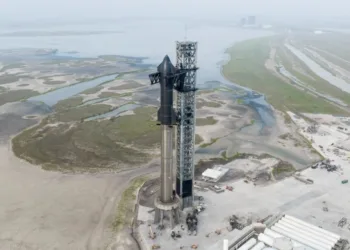SpaceX has made groundbreaking strides with the fifth test of its colossal Starship rocket system. Earlier today, the expansive rocket lifted off from the Starbase facility in South Texas, and after a brief journey into space, the reusable spacecraft successfully splashed down in the Indian Ocean.
However, the standout achievement was the successful retrieval of the Super Heavy booster, a fully reusable first stage measuring an impressive 71 meters and powered by 33 Raptor engines. In previous tests, the boosters either landed in water and sustained damage or were lost entirely, but this time, SpaceX expertly captured it using massive mechanical arms.
Starship rocket booster captured by tower pic.twitter.com/aOQmSkt6YE
— Elon Musk (@elonmusk) October 13, 2024
For the first time, the company led by Elon Musk successfully executed the “chopstick” maneuver to capture the Starship booster. This remarkable achievement involved the “mechazilla” system catching the hefty first-stage vehicle seven minutes post-launch as it gracefully descended into the arms of the structure.
“A significant stride toward enabling life on multiple planets was achieved today,” Musk noted in a post on X, the platform formerly known as Twitter.
This marks a pivotal moment as SpaceX succeeded in capturing the booster intact, avoiding the previous mishaps of explosions or watery landings. While SpaceX has a history of recovering Falcon rockets on floating platforms, the complexity and size of the Starship added considerable risk and challenges.
— Elon Musk (@elonmusk) October 13, 2024
This revolutionary technique could lead to significant cost savings for scientific missions and commercial space endeavors alike. SpaceX claims that Starship is “capable of supporting up to 150 metric tonnes fully reusable and 250 metric tonnes expendable,” and it has already secured contracts with NASA for the ambitious Artemis missions.
The launch vehicle reaches an impressive height of 121 meters and is designed to transport as many as 100 people, emphasizing its utility for long-term space exploration. With today’s test, SpaceX achieved both objectives: successfully capturing the booster and completing a spacecraft splashdown after its trip into space.
“Our engineers have dedicated years to preparing and months to testing for this booster capture attempt, investing tens of thousands of hours in building the necessary infrastructure to ensure our success,” the company stated in a recent update.
This successful test will pave the way for further trials as SpaceX advances toward fulfilling its commitments to NASA and prepares for crewed missions to the Moon and, ultimately, Mars.











